

Paraphrasing: 3 Things You Need to Know (What, How and Why?)
Paraphrasing is an essential writing tool for conveying meaning of core concepts and ideas while avoiding plagiarism. In this article, we’ll cover exactly what paraphrasing is and isn’t, the five step approach for effective paraphrasing and finally, the importance of paraphrasing beyond issues of plagiarism.
.jpg)
What is Paraphrasing?
Paraphrasing is rewording another’s written or spoken words into your own words. This is done by presenting the meaning of the original statement with new words and an altered structure. For example, the above point could be paraphrased to: “Paraphrasing means to share another’s ideas in your own words, keeping the original meaning intact by simply changing the words used or structure involved”. The original point remains, but the wording and sentence structure has changed.
The focus is to convey the meaning of the original idea using your own words. This writing technique is usually used for a short individual passage or idea, and is not to be confused with summarising. A paraphrase will often be similar in length to the original statement, and will focus on the core points of that idea. In contrast, summaries usually involve synthesising a wide range of information to share the core theme, or results of a piece of work.
How to Paraphrase
There’s a five step approach to paraphrasing effectively. First, read the material carefully to extract meaning. It’s important to develop an understanding of the points being made in order to effectively convey this meaning to another. Second, note down the key concepts. What have you understood from the passage? What key points would you like someone else to understand? Third, attempt to paraphrase this information without looking at the original. You can do this using a range of methods:
- Use synonyms to keep some of the original content, without directly using the same words. “Teachers” could be replaced by “Educators”, or “Students” could become “Undergraduates”. This depends on the content, and it’s important to make sure you still convey the core points well.
- Rearrange the content by switching the order of certain phrases or sentences. This might involve switching from an active to a passive voice. Although it's best to use the active voice, this is an ideal way to begin paraphrasing content, giving you a starting point to work on. You can continue editing the first paraphrase to ensure it’s written in a clear and concise way.
- Utilise digital tools to get you started. In genei’s notepad, you can paraphrase your notes with the click of a button, giving you new words to work with. This is ideal because you can easily work with the notes made from your readings, and minimise your workflow to one space.
Fourth, compare your paraphrased version to the original. Check if words, sentences or phrases are too similar and make edits. You can also ensure your paraphrase is effective by noting down the core ideas in your paraphrase. Do these match those originally noted from the source? Finally, be sure to cite the source! You must still acknowledge that you have paraphrased someone else’s ideas.
The Importance of Paraphrasing
Paraphrasing is an important academic skill for avoiding plagiarism . However, this isn’t the only reason paraphrasing can be important. The process of paraphrasing involves actively engaging with the material you want to rework. This can improve your own knowledge of the idea you’re working with, which can be more effective for long term understanding in comparison to simply memorising facts. Likewise, the ability to paraphrase well, is evidence that you understand the content and core ideas involved.
Beyond academia, paraphrasing still proves to be essential. This technique can act as a bridge and communication tool for sharing valuable information with a non-specialist audience. Original sources of information can be hard to digest if you’re not familiar with the subject area, however, sometimes this information still needs to be communicated. Paraphrasing allows you to tailor ideas to a particular audience, making it accessible, while still retaining the core message. For example, being able to convey important business information to a client, would require certain professional documents and plans to be paraphrased for clearer communication.

Do you want to achieve more with your time?
98% of users say genei saves them time and helps them work more productively. Why don’t you join them?
About genei
genei is an AI-powered research tool built to help make the work and research process more efficient. Our studies show genei can help improve reading speeds by up to 70%! Revolutionise your research process.
Articles you may like:

Most Popular
English and social studies teachers pioneer ai usage in schools, study finds.
10 days ago
Best Summarising Strategies for Students
How to cite page numbers in apa, what is accidental plagiarism, is summarizing books a good way to retain knowledge redditors weigh in, why is paraphrasing important.
Image: unsplash.com

Paraphrasing is a fundamental skill sitting at the crossroads of comprehension, expression, and academic integrity. In academic environment, paraphrasing holds significance due to a number of reasons. It’s an excellent mental workout that pushes the boundaries of your understanding and critical thinking. By rewording, you learn to articulate complex ideas in your own words, an invaluable skill for everyone in all fields. Moreover, paraphrasing plays a key role in maintaining academic integrity, allowing students to incorporate and acknowledge others’ ideas within their work. Continue reading to learn everything about the importance of paraphrasing.
Paraphrasing and Skill Development
When done effectively, paraphrasing has several benefits that simple rewording can’t produce. It is a comprehensive ability that greatly contributes to academic and intellectual development. Let’s look at some of the important advantages:
Don’t Believe? Try our Free Paraphraser to get an Example
Paraphrasing and its impact on academic papers.
Paraphrasing is a part of academic writing. It links current information and fresh discoveries, enabling authors to include authoritative sources into their writings as a careful integration that adds depth and uniqueness. When done well, paraphrasing indicates the author’s understanding of the original material, demonstrating that they not only can grasp complicated topics but also explain them in a new way. This helps to build a stronger, more compelling argument by anchoring theoretical ideas in proven research and avoiding the problems of plagiarism.
Moreover, effective paraphrasing improves the academic paper by introducing diversity in expression and preventing monotony, keeping readers engaged. It allows the writer to maintain a consistent voice throughout the document, creating the paper as a cohesive story rather than a patchwork of disconnected quotations. This coherence is critical for the reader’s understanding and for conveying the author’s perspective on the topic.
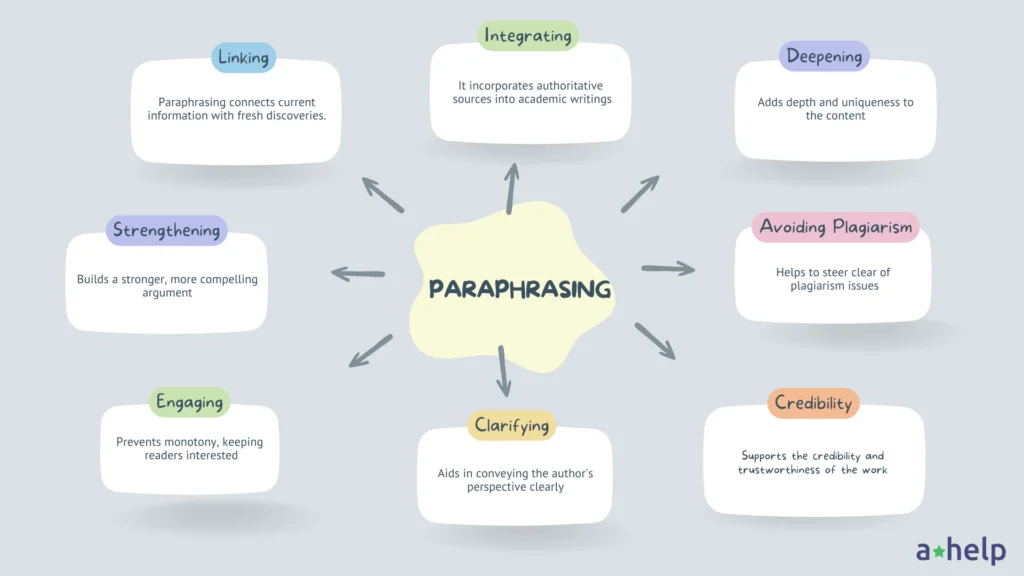
Equally important is the ethical aspect of paraphrasing. Properly rephrased and cited, it maintains the integrity of academic work, distinguishing it from plagiarism and unauthorized use of intellectual property. This ethical practice supports the credibility and trustworthiness of the paper itself.
To sum up, paraphrasing significantly impacts academic papers by promoting understanding, originality, and ethical standards. It demonstrates the author’s capacity to participate in and contribute to academic dialogue, making it a valuable skill in the scholarly community.
What distinguishes effective paraphrasing from simple rewording?
Effective paraphrasing involves a deep understanding of the original material, allowing the paraphraser to convey the same ideas in a completely new way that reflects their voice and style. True paraphrasing demonstrates comprehension and the ability to critically engage with the text, thereby adding value to the academic discourse. In contrast, simple rewording often results in a piece that is too close to the source, lacking originality and failing to fully grasp the underlying concepts.
Can paraphrasing tools ensure academic integrity?
While paraphrasing tools can aid in rephrasing text, they do not guarantee academic integrity on their own. These tools may provide a starting point for rewriting content, but they often lack the nuance and understanding required for true paraphrasing. Academic integrity involves correctly interpreting and crediting the source material, a process that requires human judgment and ethical consideration. Thus, while paraphrasing tools can be helpful, they should be used cautiously, with the final work carefully reviewed and adjusted to ensure it meets academic standards.
How does paraphrasing contribute to the development of academic writing style?
Paraphrasing contributes to the development of academic writing style by enhancing clarity, precision, and personal voice. It encourages deeper engagement with source material, leading to better critical thinking and analytical skills. Through paraphrasing, writers expand their vocabulary and learn to express complex ideas in their own manner, making their arguments more cohesive.
Follow us on Reddit for more insights and updates.
Comments (0)
Welcome to A*Help comments!
We’re all about debate and discussion at A*Help.
We value the diverse opinions of users, so you may find points of view that you don’t agree with. And that’s cool. However, there are certain things we’re not OK with: attempts to manipulate our data in any way, for example, or the posting of discriminative, offensive, hateful, or disparaging material.
Cancel reply
Your email address will not be published. Required fields are marked *
Save my name, email, and website in this browser for the next time I comment.
More from Paraphrasing Guides
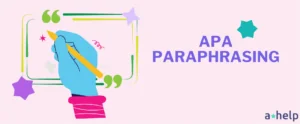
APA Paraphrasing
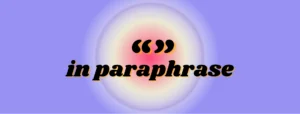
Do Paraphrases Need Quotation Marks

How to Rewrite the Sentence in Active Voice
Remember Me
What is your profession ? Student Teacher Writer Other
Forgotten Password?
Username or Email
About Stanford GSB
- The Leadership
- Dean’s Updates
- School News & History
- Commencement
- Business, Government & Society
- Centers & Institutes
- Center for Entrepreneurial Studies
- Center for Social Innovation
- Stanford Seed
About the Experience
- Learning at Stanford GSB
- Experiential Learning
- Guest Speakers
- Entrepreneurship
- Social Innovation
- Communication
- Life at Stanford GSB
- Collaborative Environment
- Activities & Organizations
- Student Services
- Housing Options
- International Students
Full-Time Degree Programs
- Why Stanford MBA
- Academic Experience
- Financial Aid
- Why Stanford MSx
- Research Fellows Program
- See All Programs
Non-Degree & Certificate Programs
- Executive Education
- Stanford Executive Program
- Programs for Organizations
- The Difference
- Online Programs
- Stanford LEAD
- Seed Transformation Program
- Aspire Program
- Seed Spark Program
- Faculty Profiles
- Academic Areas
- Awards & Honors
- Conferences
Faculty Research
- Publications
- Working Papers
- Case Studies
Research Hub
- Research Labs & Initiatives
- Business Library
- Data, Analytics & Research Computing
- Behavioral Lab
Research Labs
- Cities, Housing & Society Lab
- Golub Capital Social Impact Lab
Research Initiatives
- Corporate Governance Research Initiative
- Corporations and Society Initiative
- Policy and Innovation Initiative
- Rapid Decarbonization Initiative
- Stanford Latino Entrepreneurship Initiative
- Value Chain Innovation Initiative
- Venture Capital Initiative
- Career & Success
- Climate & Sustainability
- Corporate Governance
- Culture & Society
- Finance & Investing
- Government & Politics
- Leadership & Management
- Markets & Trade
- Operations & Logistics
- Opportunity & Access
- Organizational Behavior
- Political Economy
- Social Impact
- Technology & AI
- Opinion & Analysis
- Email Newsletter
Welcome, Alumni
- Communities
- Digital Communities & Tools
- Regional Chapters
- Women’s Programs
- Identity Chapters
- Find Your Reunion
- Career Resources
- Job Search Resources
- Career & Life Transitions
- Programs & Services
- Career Video Library
- Alumni Education
- Research Resources
- Volunteering
- Alumni News
- Class Notes
- Alumni Voices
- Contact Alumni Relations
- Upcoming Events
Admission Events & Information Sessions
- MBA Program
- MSx Program
- PhD Program
- Alumni Events
- All Other Events
Matt Abrahams: The Power of the Paraphrase
An expert on public speaking shows how paraphrasing can help you navigate tricky communication situations.
November 19, 2014

A job seeker raises his hand to ask a question | Reuters/Rick Wilking
When you are giving a public presentation, don’t you hate it when you face … the dreaded question. You know the one: the emotionally loaded challenge that serves to undermine everything you presented prior. You had hoped you wouldn’t get it, but here it is. Or, you may face … the obnoxious meeting participant. You know this guy: He thinks he’s Mr. Smarty-Pants and wants everyone to know it. He ruins your meeting by going on long rants that contribute little and waste much.
These two situations can make even the most confident and calm speaker nervous. One powerful way to navigate your way through these two tricky communication situations is to rely on paraphrasing. Paraphrasing is a listening and reflecting tool where you restate what others say in your own words. The most effective paraphrases concisely capture the essence of what another speaker says. For example, at the end of your presentation a questioner asks: “In the past you have been slow to release new products. How soon will your new product be available?” You might paraphrase her question in one of the following ways:
- “You’re asking about our availability.”
- “You’d like to know about our release schedule.”
- “Our release timeline will be … ”
Effective paraphrasing affords you several benefits. In Q&A sessions, for instance, it allows you to:
Make sure you understood the question correctly. After your paraphrase, the question asker has the opportunity to correct you or refine his or her question. There is no sense in answering a question you were not asked.
Think before you respond. Paraphrasing is not very mentally taxing, so while you are speaking your paraphrase you can begin to think of your response.
Acknowledge emotions prior to addressing the issue(s). Occasionally, you may find yourself confronted with an emotionally laden question. In order to be seen as empathetic, and to get the asker to “hear” your answer, you should recognize the emotion as part of your paraphrase. To a questioner who asks, “I get really exasperated when I try to use some of your features. How are you going to make it easier to use your product?” you might say: “I hear that you have emotion around the complexity of our offering.” By acknowledging the emotion, you can more easily move beyond it to address the issue at hand. Please note that you should avoid labeling the emotion, even if the asker does. If someone seems angry, it is better to use terms such as “strong emotion,” “clear concern,” and “passion.” I have seen a number of speakers get into a labeling battle with an audience member when the speaker names a specific emotion that the asker took offense to (e.g., saying an audience member seems frustrated when he is actually angry).
Reframe the question to focus on something you feel more comfortable addressing. I am not recommending pulling a politician’s trick and pivoting to answer the question you wanted rather than the one you got. Instead, by paraphrasing, you can make the question more comfortable for you to answer. The most striking example I have come across was in a sales situation where a prospect asked the presenter: “How come your prices are ridiculously expensive?” Clearly, the paraphrase “So you’re asking about our ridiculous pricing” is not the way to go. Rather, you can reframe the issue in your paraphrase to be about a topic you are better prepared to address. For example, “So you’d like to know about our product’s value.” Price is clearly part of value, but you start by describing the value and return on investment, which will likely soften the blow of the price.
Using paraphrases can also help you in facilitation situations, such as a meeting. In meetings, paraphrasing allows you to:
Acknowledge the participant’s effort. For many people, contributing in meetings can be daunting. There are real consequences for misspeaking or sounding unprepared. By paraphrasing the contributions you get from others, you validate the person’s effort by signaling that you really listened and valued their input.
Link various questions/ideas. You can pull together disparate contributions and questions and engage different participants by relating a current statement to previous ones. For example, you might say: “Your comment about our profitability links to the question a few minutes ago about our financial outlook.”
Manage over-contributors. Someone who over-shares or dominates a meeting with his or her opinions can be very disruptive and disrespectful. If it is your meeting, then the other participants will expect you to manage the situation. If you don’t, you will lose control and potentially credibility. Paraphrasing can help you move beyond the over-contributor while looking tactful. Fortunately, even the most loquacious person needs to inhale once in a while. During a pause, simply paraphrase a meaningful portion of the person’s diatribe and place focus elsewhere — to another person or topic. For example, you might say, “Forrest’s point about manufacturing delays is a good one. Laurie, what do you think?” Or, “Forrest’s point about manufacturing delays is a good one. What other issues are affecting our release schedule?” In both cases, you have politely informed Forrest that he is done, and you’ve turned the focus away from him and back to your agenda.
Beginning a paraphrase can sometimes be tricky, and people often ask me for suggestions for ways to initiate their paraphrases. Try one of the following lines to help you start your paraphrase:
- “So what you are saying/asking is … ”
- “What is important to you is … ”
- “You’d like to know more about … ”
- “The central idea of your question/comment is … ”
Paraphrasing has the power to help you connect with your audience, manage emotions, and steer the conversation. And once you begin to use the technique, you will realize it has the power to help you not only in presentations and meetings, but in virtually any interpersonal conversation.
For media inquiries, visit the Newsroom .
Explore More
Lose yourself: the secret to finding flow and being fully present, speak your truth: why authenticity leads to better communication, when words aren’t enough: how to excel at nonverbal communication, editor’s picks.

July 25, 2014 Matt Abrahams: A Good Question Can Be the Key to a Successful Presentation A Stanford GSB lecturer and expert on public speaking explains how you can become a more compelling and confident presenter by asking – not telling – in the right situations.
March 13, 2014 Matt Abrahams: How to Make Unforgettable Presentations A Stanford lecturer and expert on public speaking explains how to ensure your audience remembers what they hear and see.
March 04, 2014 Matt Abrahams: Presentations and the Art of the Graceful Recovery A Stanford lecturer and expert on public speaking explains what to do when memory fails.
February 26, 2014 Matt Abrahams: How Do You Make a Memorable Presentation? A Stanford lecturer and expert on public speaking explains how to manage anxiety and deliver a smooth presentation.
- Priorities for the GSB's Future
- See the Current DEI Report
- Supporting Data
- Research & Insights
- Share Your Thoughts
- Search Fund Primer
- Teaching & Curriculum
- Affiliated Faculty
- Faculty Advisors
- Louis W. Foster Resource Center
- Defining Social Innovation
- Impact Compass
- Global Health Innovation Insights
- Faculty Affiliates
- Student Awards & Certificates
- Changemakers
- Dean Jonathan Levin
- Dean Garth Saloner
- Dean Robert Joss
- Dean Michael Spence
- Dean Robert Jaedicke
- Dean Rene McPherson
- Dean Arjay Miller
- Dean Ernest Arbuckle
- Dean Jacob Hugh Jackson
- Dean Willard Hotchkiss
- Faculty in Memoriam
- Stanford GSB Firsts
- Certificate & Award Recipients
- Teaching Approach
- Analysis and Measurement of Impact
- The Corporate Entrepreneur: Startup in a Grown-Up Enterprise
- Data-Driven Impact
- Designing Experiments for Impact
- Digital Business Transformation
- The Founder’s Right Hand
- Marketing for Measurable Change
- Product Management
- Public Policy Lab: Financial Challenges Facing US Cities
- Public Policy Lab: Homelessness in California
- Lab Features
- Curricular Integration
- View From The Top
- Formation of New Ventures
- Managing Growing Enterprises
- Startup Garage
- Explore Beyond the Classroom
- Stanford Venture Studio
- Summer Program
- Workshops & Events
- The Five Lenses of Entrepreneurship
- Leadership Labs
- Executive Challenge
- Arbuckle Leadership Fellows Program
- Selection Process
- Training Schedule
- Time Commitment
- Learning Expectations
- Post-Training Opportunities
- Who Should Apply
- Introductory T-Groups
- Leadership for Society Program
- Certificate
- 2023 Awardees
- 2022 Awardees
- 2021 Awardees
- 2020 Awardees
- 2019 Awardees
- 2018 Awardees
- Social Management Immersion Fund
- Stanford Impact Founder Fellowships and Prizes
- Stanford Impact Leader Prizes
- Social Entrepreneurship
- Stanford GSB Impact Fund
- Economic Development
- Energy & Environment
- Stanford GSB Residences
- Environmental Leadership
- Stanford GSB Artwork
- A Closer Look
- California & the Bay Area
- Voices of Stanford GSB
- Business & Beneficial Technology
- Business & Sustainability
- Business & Free Markets
- Business, Government, and Society Forum
- Get Involved
- Second Year
- Global Experiences
- JD/MBA Joint Degree
- MA Education/MBA Joint Degree
- MD/MBA Dual Degree
- MPP/MBA Joint Degree
- MS Computer Science/MBA Joint Degree
- MS Electrical Engineering/MBA Joint Degree
- MS Environment and Resources (E-IPER)/MBA Joint Degree
- Academic Calendar
- Clubs & Activities
- LGBTQ+ Students
- Military Veterans
- Minorities & People of Color
- Partners & Families
- Students with Disabilities
- Student Support
- Residential Life
- Student Voices
- MBA Alumni Voices
- A Week in the Life
- Career Support
- Employment Outcomes
- Cost of Attendance
- Knight-Hennessy Scholars Program
- Yellow Ribbon Program
- BOLD Fellows Fund
- Application Process
- Loan Forgiveness
- Contact the Financial Aid Office
- Evaluation Criteria
- GMAT & GRE
- English Language Proficiency
- Personal Information, Activities & Awards
- Professional Experience
- Letters of Recommendation
- Optional Short Answer Questions
- Application Fee
- Reapplication
- Deferred Enrollment
- Joint & Dual Degrees
- Entering Class Profile
- Event Schedule
- Ambassadors
- New & Noteworthy
- Ask a Question
- See Why Stanford MSx
- Is MSx Right for You?
- MSx Stories
- Leadership Development
- Career Advancement
- Career Change
- How You Will Learn
- Admission Events
- Personal Information
- Information for Recommenders
- GMAT, GRE & EA
- English Proficiency Tests
- After You’re Admitted
- Daycare, Schools & Camps
- U.S. Citizens and Permanent Residents
- Requirements
- Requirements: Behavioral
- Requirements: Quantitative
- Requirements: Macro
- Requirements: Micro
- Annual Evaluations
- Field Examination
- Research Activities
- Research Papers
- Dissertation
- Oral Examination
- Current Students
- Education & CV
- International Applicants
- Statement of Purpose
- Reapplicants
- Application Fee Waiver
- Deadline & Decisions
- Job Market Candidates
- Academic Placements
- Stay in Touch
- Faculty Mentors
- Current Fellows
- Standard Track
- Fellowship & Benefits
- Group Enrollment
- Program Formats
- Developing a Program
- Diversity & Inclusion
- Strategic Transformation
- Program Experience
- Contact Client Services
- Campus Experience
- Live Online Experience
- Silicon Valley & Bay Area
- Digital Credentials
- Faculty Spotlights
- Participant Spotlights
- Eligibility
- International Participants
- Stanford Ignite
- Frequently Asked Questions
- Operations, Information & Technology
- Classical Liberalism
- The Eddie Lunch
- Accounting Summer Camp
- Videos, Code & Data
- California Econometrics Conference
- California Quantitative Marketing PhD Conference
- California School Conference
- China India Insights Conference
- Homo economicus, Evolving
- Political Economics (2023–24)
- Scaling Geologic Storage of CO2 (2023–24)
- A Resilient Pacific: Building Connections, Envisioning Solutions
- Adaptation and Innovation
- Changing Climate
- Civil Society
- Climate Impact Summit
- Climate Science
- Corporate Carbon Disclosures
- Earth’s Seafloor
- Environmental Justice
- Operations and Information Technology
- Organizations
- Sustainability Reporting and Control
- Taking the Pulse of the Planet
- Urban Infrastructure
- Watershed Restoration
- Junior Faculty Workshop on Financial Regulation and Banking
- Ken Singleton Celebration
- Marketing Camp
- Quantitative Marketing PhD Alumni Conference
- Presentations
- Theory and Inference in Accounting Research
- Stanford Closer Look Series
- Quick Guides
- Core Concepts
- Journal Articles
- Glossary of Terms
- Faculty & Staff
- Researchers & Students
- Research Approach
- Charitable Giving
- Financial Health
- Government Services
- Workers & Careers
- Short Course
- Adaptive & Iterative Experimentation
- Incentive Design
- Social Sciences & Behavioral Nudges
- Bandit Experiment Application
- Conferences & Events
- Reading Materials
- Energy Entrepreneurship
- Faculty & Affiliates
- SOLE Report
- Responsible Supply Chains
- Current Study Usage
- Pre-Registration Information
- Participate in a Study
- Founding Donors
- Location Information
- Participant Profile
- Network Membership
- Program Impact
- Collaborators
- Entrepreneur Profiles
- Company Spotlights
- Seed Transformation Network
- Responsibilities
- Current Coaches
- How to Apply
- Meet the Consultants
- Meet the Interns
- Intern Profiles
- Collaborate
- Research Library
- News & Insights
- Program Contacts
- Databases & Datasets
- Research Guides
- Consultations
- Research Workshops
- Career Research
- Research Data Services
- Course Reserves
- Course Research Guides
- Material Loan Periods
- Fines & Other Charges
- Document Delivery
- Interlibrary Loan
- Equipment Checkout
- Print & Scan
- MBA & MSx Students
- PhD Students
- Other Stanford Students
- Faculty Assistants
- Research Assistants
- Stanford GSB Alumni
- Telling Our Story
- Staff Directory
- Site Registration
- Alumni Directory
- Alumni Email
- Privacy Settings & My Profile
- Success Stories
- The Story of Circles
- Support Women’s Circles
- Stanford Women on Boards Initiative
- Alumnae Spotlights
- Insights & Research
- Industry & Professional
- Entrepreneurial Commitment Group
- Recent Alumni
- Half-Century Club
- Fall Reunions
- Spring Reunions
- MBA 25th Reunion
- Half-Century Club Reunion
- Faculty Lectures
- Ernest C. Arbuckle Award
- Alison Elliott Exceptional Achievement Award
- ENCORE Award
- Excellence in Leadership Award
- John W. Gardner Volunteer Leadership Award
- Robert K. Jaedicke Faculty Award
- Jack McDonald Military Service Appreciation Award
- Jerry I. Porras Latino Leadership Award
- Tapestry Award
- Student & Alumni Events
- Executive Recruiters
- Interviewing
- Land the Perfect Job with LinkedIn
- Negotiating
- Elevator Pitch
- Email Best Practices
- Resumes & Cover Letters
- Self-Assessment
- Whitney Birdwell Ball
- Margaret Brooks
- Bryn Panee Burkhart
- Margaret Chan
- Ricki Frankel
- Peter Gandolfo
- Cindy W. Greig
- Natalie Guillen
- Carly Janson
- Sloan Klein
- Sherri Appel Lassila
- Stuart Meyer
- Tanisha Parrish
- Virginia Roberson
- Philippe Taieb
- Michael Takagawa
- Terra Winston
- Johanna Wise
- Debbie Wolter
- Rebecca Zucker
- Complimentary Coaching
- Changing Careers
- Work-Life Integration
- Career Breaks
- Flexible Work
- Encore Careers
- D&B Hoovers
- Data Axle (ReferenceUSA)
- EBSCO Business Source
- Global Newsstream
- Market Share Reporter
- ProQuest One Business
- Student Clubs
- Entrepreneurial Students
- Stanford GSB Trust
- Alumni Community
- How to Volunteer
- Springboard Sessions
- Consulting Projects
- 2020 – 2029
- 2010 – 2019
- 2000 – 2009
- 1990 – 1999
- 1980 – 1989
- 1970 – 1979
- 1960 – 1969
- 1950 – 1959
- 1940 – 1949
- Service Areas
- ACT History
- ACT Awards Celebration
- ACT Governance Structure
- Building Leadership for ACT
- Individual Leadership Positions
- Leadership Role Overview
- Purpose of the ACT Management Board
- Contact ACT
- Business & Nonprofit Communities
- Reunion Volunteers
- Ways to Give
- Fiscal Year Report
- Business School Fund Leadership Council
- Planned Giving Options
- Planned Giving Benefits
- Planned Gifts and Reunions
- Legacy Partners
- Giving News & Stories
- Giving Deadlines
- Development Staff
- Submit Class Notes
- Class Secretaries
- Board of Directors
- Health Care
- Sustainability
- Class Takeaways
- All Else Equal: Making Better Decisions
- If/Then: Business, Leadership, Society
- Grit & Growth
- Think Fast, Talk Smart
- Spring 2022
- Spring 2021
- Autumn 2020
- Summer 2020
- Winter 2020
- In the Media
- For Journalists
- DCI Fellows
- Other Auditors
- Academic Calendar & Deadlines
- Course Materials
- Entrepreneurial Resources
- Campus Drive Grove
- Campus Drive Lawn
- CEMEX Auditorium
- King Community Court
- Seawell Family Boardroom
- Stanford GSB Bowl
- Stanford Investors Common
- Town Square
- Vidalakis Courtyard
- Vidalakis Dining Hall
- Catering Services
- Policies & Guidelines
- Reservations
- Contact Faculty Recruiting
- Lecturer Positions
- Postdoctoral Positions
- Accommodations
- CMC-Managed Interviews
- Recruiter-Managed Interviews
- Virtual Interviews
- Campus & Virtual
- Search for Candidates
- Think Globally
- Recruiting Calendar
- Recruiting Policies
- Full-Time Employment
- Summer Employment
- Entrepreneurial Summer Program
- Global Management Immersion Experience
- Social-Purpose Summer Internships
- Process Overview
- Project Types
- Client Eligibility Criteria
- Client Screening
- ACT Leadership
- Social Innovation & Nonprofit Management Resources
- Develop Your Organization’s Talent
- Centers & Initiatives
- Student Fellowships
- Library Catalogue
Techniques for effective paraphrasing
On this page, techniques for paraphrasing, getting started, effective paraphrasing.
Paraphrasing is an important skill for academic writing, and yet it is very often misunderstood. Commonly, paraphrasing is expressed as “restating someone else’s ideas in your own words.” While this is technically accurate, it can lead students to believe that paraphrasing is simply about finding synonyms to replace the words in the original author’s text. Paraphrasing is most effective and useful when you think about it as a way to explain someone else’s ideas in relation to, or in the context of, your own argument.
When writers are new to paraphrasing, they might think it’s acceptable to simply substitute certain words with synonyms. Here is an example, taken from the writing handbook They Say/I Say by Gerald Graff and Cathy Birkenstein :
“Whenever you enter into a conversation with others in your writing, then, it is extremely important that you go back to what those others have said, that you study it very closely, and that you not confuse it with something you already believe” (2014, p. 33).
If a writer was told to “put this sentence into her own words,” and simply tried to find synonyms, they might end up with something like this:
Anytime someone dialogues with different authors, it is crucial that they return to what those different authors have said, that they scrutinize it, and that they avoid mistaking it for what they previously accepted (Graff & Birkenstein, 2014, p. 33).
You will notice that this example uses very few of the same words as the original quotation (i.e., it has been put into the author’s “own words”). However, it might be difficult for the reader to understand.
More seriously, this paraphrase could be considered plagiarism or patch-writing —even though the source is cited! Why?
Substituting synonyms for some of the author’s original words does not explain the source, highlight its importance, or show the reader how the source helps convey the paper’s argument. To do these things, an acceptable paraphrase must also change the structure of the author’s expression.
Here is an example of an effective paraphrase of the quotation above:
Graff and Birkenstein (2014) argue throughout their book They Say/I Say that writing is a conversation. When engaging in this conversation, they caution that writers must read carefully in order to ensure that they both understand, and provide fair consideration to, the ideas of others.
Notice three crucial things about this paraphrase:
- The author has signalled that the idea comes from the source They Say/I Say (this signalling can be done within the sentence, as it is above, or it can be done through an in-text citation).
- The author has “zoomed out” from the original quotation in order to explain the big idea being presented in the source text.
- The author has changed the original structure by making two sentences from one. This step helps to accomplish both #1 and #2, above.
Rather than being about words , paraphrasing is about ideas . Instead of focusing on replacing specific words in a quotation, it is more helpful when paraphrasing to think deeply about the ideas that the original author is explaining. Once you understand those ideas, you can “zoom out” and explain the most important idea (or ideas) in your own way.
Try these steps to write an effective paraphrase
Step 1: Read a paragraph from an article that you find interesting or that you are using to write a paper.
Step 2: Make notes to yourself about the most important idea or ideas presented in the paragraph (make these notes in point form, rather than in sentences)
Step 3: Put the article away and, using only your point-form notes, explain the most important idea(s) to someone else.

- TEFL Internship
- TEFL Masters
- Find a TEFL Course
- Special Offers
- Course Providers
- Teach English Abroad
- Find a TEFL Job
- About DoTEFL
- Our Mission
- How DoTEFL Works
Forgotten Password

- What is Paraphrasing? An Overview With Examples
- Learn English
- James Prior
- No Comments
- Updated February 23, 2024
What is paraphrasing? Or should I say what is the definition of paraphrasing? If you want to restate something using different words whilst retaining the same meaning, this is paraphrasing.
In this article, we cover what paraphrasing is, why it’s important, and when you should do it. Plus, some benefits and examples.

Table of Contents
Paraphrase Definition: What is Paraphrasing?
Paraphrasing is when you restate the information from a source using your own words while maintaining the original meaning. It involves expressing the ideas in a different way, often to clarify or simplify the content, without directly quoting the source.
When you paraphrase, you are not only borrowing, clarifying, or expanding on the information but also ensuring that you do all of these actions without plagiarizing the original content. It’s therefore definitely worth learning how to paraphrase if you want to improve your writing skills.
Why is Paraphrasing Important?
Paraphrasing is a valuable skill that allows you to convey information in your unique writing style while still giving credit to someone else’s ideas. It’s important for several reasons, and it serves various functions in both academic and professional writing.
Here are some key reasons why you should paraphrase:
- Paraphrasing allows you to present information from sources in your own words, reducing the risk of plagiarism. Proper in-text citation is still necessary, but paraphrasing demonstrates your understanding and interpretation of the material.
- When you paraphrase, you are required to comprehend the original content fully. You actively engage with the information, helping you better understand complex concepts and ideas. This process of restating the information in your own words showcases your understanding of the subject matter.
- By paraphrasing, you can clarify complex ideas or technical language and convey information in a clearer, shorter, and simpler form. This makes it more accessible to your audience and ensures they grasp the key points. This is particularly important when communicating with readers who may not be familiar with specialized terminology.
- Paraphrasing is valuable when synthesizing information from various sources. It enables you to blend ideas cohesively while maintaining a consistent writing style throughout your work.
- Paraphrasing allows you to inject your unique writing style and voice into the content. It helps you present information in a way that is more aligned with your personal expression and perspective.
- In certain situations where you need to meet specific length requirements for assignments or publications, paraphrasing allows you to convey information more concisely while still preserving the essential meaning.
- Paraphrasing helps maintain a smooth flow and cohesiveness in your writing. It allows you to integrate information seamlessly, avoiding abrupt shifts between your own ideas and those from external sources.
- Depending on your audience, you may need to adapt the language and level of technicality of the information you present. Paraphrasing allows you to tailor the content to suit the needs of your specific readership.
Incorporating paraphrasing into your writing not only showcases your understanding of the material but also enhances the overall quality and originality of your work.
When Should You Paraphrase?
Knowing when to paraphrase is an important skill, especially in academic writing and professional communication. Here are some situations in which you should consider paraphrasing:
- To Avoid Plagiarism: Whenever you want to incorporate information from source material into your own work, but don’t want to use a direct quotation, paraphrasing is necessary to present the ideas in your own words while still acknowledging the original source.
- To Express Understanding: Paraphrasing demonstrates your understanding of a topic by rephrasing the information in a way that shows you have processed and comprehended the material.
- To Simplify Complex Information: If you encounter complex or technical language that may be difficult for your audience to understand, paraphrasing can help you clarify and simplify the information to make it more accessible and digestible.
- To Integrate Multiple Sources: When synthesizing information from multiple sources, paraphrasing allows you to blend the ideas cohesively while maintaining your own voice and perspective.
- To Maintain Consistency in Writing Style: In academic writing or professional writing, paraphrasing can help you maintain a consistent writing style throughout your work. This helps to ensure that all sections flow smoothly and are coherent.
- To Meet Specific Requirements: Some assignments or publications may have specific requirements. This could relate to the number of words or concern the use of direct quotations. In such cases, paraphrasing allows you to meet these requirements while still incorporating relevant information from your sources.
What Are the Benefits of Paraphrasing?
Rewriting information in a clearer, shorter, and simpler form is called paraphrasing, so one of the benefits of paraphrasing is already clear! However, it can also be a useful exercise for other reasons, which are outlined below:
Avoiding Plagiarism
One of the main benefits of paraphrasing is mastering the ability to present information from external sources in a way that is entirely your own. By restructuring the content and expressing it using your words, you create a distinct piece of writing that reflects your comprehension and interpretation of the original material. This not only showcases your academic or professional integrity but also safeguards against unintentional plagiarism.
Paraphrasing is a fundamental skill in academic and professional settings, where originality and proper attribution are highly valued. This is especially true when it comes to writing research papers, where you’ll often need to reference someone else’s ideas with appropriate citations.
When you paraphrase effectively, you communicate to your audience that you respect the intellectual property of others while contributing your unique insights. This ethical approach to information usage enhances your credibility as a writer or researcher and reinforces the integrity of your work.
Enhancing Understanding
When you engage in paraphrasing, you actively participate in the material you are working with. You are forced to consider the ideas presented in the source material. You need to discern the essential concepts, identify key phrases, and decide how best to convey the message in a way that resonates with you.
This active engagement not only aids in understanding the content but also encourages critical thinking as you evaluate and interpret the information from your own standpoint.
By expressing someone else’s ideas in your own words, you deepen your understanding of the content. This process requires you to dissect the original text, grasp its nuances, and then reconstruct it using your language and perspective. In this way, you go beyond mere memorization and truly internalize the information, fostering a more profound comprehension of the subject matter.
Tailoring Information for Your Audience
Paraphrasing empowers you to adapt the language and complexity of the information to suit the needs and understanding of your audience. As you rephrase the content, you have the flexibility to adjust the level of technicality, simplify complex terminology, or tailor the tone to make the information more accessible to your specific readership.
Consider your audience’s background, knowledge level, and interests. Paraphrasing allows you to bridge the gap between the original content and the understanding of your intended audience.
Whether you are communicating with experts in a particular field or a general audience, the ability to paraphrase ensures that the information is conveyed in a way that resonates with and is comprehensible to your readers. This skill not only facilitates effective communication but also demonstrates your awareness of the diverse needs of your audience.
Improves Writing Skills
Paraphrasing helps in the development and refinement of your writing skills. When you actively engage in the process of rephrasing someone else’s ideas, you hone your ability to express concepts in a clear, concise, and coherent manner.
This practice refines your language proficiency, encouraging you to explore different types of sentence structure, experiment with vocabulary, and ultimately develop a more sophisticated and nuanced writing style.
As you paraphrase, you gain a heightened awareness of grammar, syntax, and word choice. This translates into improved writing, helping you construct well-articulated sentences and paragraphs. Moreover, paraphrasing allows you to experiment with different writing tones and adapt your style to suit the context or purpose of your writing, fostering versatility and adaptability in your expression.
Saves Time and Energy
Paraphrasing can significantly reduce the time and energy spent on the writing process. Rather than grappling with the challenge of integrating lengthy direct quotations or struggling to find the perfect synonym, paraphrasing allows you to distill and convey information in a more streamlined way.
This becomes particularly advantageous when faced with strict deadlines. By mastering paraphrasing, you empower yourself to produce well-crafted, original content in a shorter timeframe, allowing you to meet deadlines without compromising the quality of your work.
Examples of Paraphrasing
Here are some examples of paraphrasing:
- Original: “The advancements in technology have revolutionized the way we communicate with each other.”
- Paraphrased: “Technological progress has transformed how we interact and communicate with one another.”
- Original: “Deforestation poses a significant threat to global ecosystems and biodiversity.”
- Paraphrased: “The impact of deforestation represents a substantial danger to ecosystems and the diversity of life on a global scale.”
- Original: “Effective time management is essential for achieving productivity in both professional and personal spheres.”
- Paraphrased: “Efficient management of time is crucial for attaining productivity in both professional and personal aspects of life.”
- Original: “The restaurant offers a diverse selection of culinary choices, ranging from traditional dishes to modern fusion cuisine.”
- Paraphrased: “The restaurant provides a variety of food options, including both traditional and modern fusion dishes.”
- Original: “The novel explores the complexities of human relationships in a rapidly changing society.”
- Paraphrased: “The book delves into the challenges of human connections in a fast-changing world.”
- Original: “Regular exercise is crucial for maintaining optimal physical health and preventing various health issues.”
- Paraphrased: “Exercising regularly is important for keeping your body healthy and avoiding health problems.”
In these examples, you can observe the use of different wording, sentence structure, and synonyms while preserving the core meaning of the original sentences. This is the essence of paraphrasing.
What Are the Differences Between Paraphrasing, Quoting, and Summarizing?
So, we’ve established that successful paraphrasing is a way of rewriting someone else’s words whilst retaining their meaning and still giving credit to the original author’s ideas. But how is this different from quoting and summarizing?
While paraphrasing, quoting, and summarizing are all ways of incorporating information from source material into your own writing, there are key differences between them:
Paraphrasing
- Definition: Paraphrasing involves rephrasing someone else’s ideas or information in your own words while retaining the original meaning.
- Usage: You use paraphrasing when you want to present the information in a way that suits your writing style or when you need to clarify complex ideas.
- Example: Original: “The study found a significant correlation between sleep deprivation and decreased cognitive performance.” Paraphrased: “The research indicated a notable link between lack of sleep and a decline in cognitive function.”
- Definition: Quoting involves directly using the exact words from a source and enclosing them in quotation marks.
- Usage: You use quoting when the original wording is essential, either because of its precision or uniqueness, or when you want to highlight a specific phrase or concept.
- Example: Original: “The author argues, ‘In the absence of clear guidelines, individual judgment becomes paramount in decision-making.'”
The use of quotation marks is vital when quoting.
Summarizing
- Definition: Summarizing involves condensing the main ideas of a source or original passage in your own words, focusing on the most crucial points.
- Usage: You use summarizing when you need to provide a concise overview of a longer piece of text or when you want to capture the key points without including all the details.
- Example: Original: A lengthy article discussing various factors influencing climate change. Summary: “The article outlines key factors contributing to climate change, including human activities and natural processes.”
In summary, paraphrasing is about expressing someone else’s ideas in your own words, quoting involves directly using the original words, and summarizing is about condensing the main points of a source.
Each technique serves different purposes in writing and should be used based on your specific goals and the nature of the information you are incorporating. If you want to level up your writing skills you need to be able to do all three of these.
Conclusion (In Our Own Words)
Paraphrasing is a valuable skill with numerous benefits. It helps you understand complex ideas, refine your writing style, and demonstrate ethical information use. It also allows you to tailor information for different audiences and can save time in academic and professional writing.
So, if you want to incorporate information from external sources into your writing in a way that is clear, concise, and respectful of the original author’s work, it’s worth mastering the art of paraphrasing.
- Recent Posts
- How to Write a TOEFL Essay - April 22, 2024
- What Can You Do with a TEFL Certificate? - April 5, 2024
- 19 Best Learning Management System Examples for 2024 - April 4, 2024
More from DoTEFL

Co-Teaching: What is it & How to Make it Work?
- Updated February 26, 2024

11 of the Best English Learning Apps For English Learners
- Updated January 8, 2024

45 Unique Ways to Say “Have a Safe Flight”
- Updated February 13, 2024

25 Fun Games to Play on Zoom With Your Students
- Updated May 12, 2023

81 of the Most Commonly Misspelled Words in English
- Updated September 30, 2023

How to Become a Translator: What You Need to Know
- Updated February 2, 2024
- The global TEFL course directory.
- Literary Terms
- Definition & Examples
- When & How to Use Paraphrase
I. What is a Paraphrase?
A paraphrase (pronounced par – uh -freyz) is a restatement or rewording of a paragraph or text, in order to borrow, clarify, or expand on information without plagiarizing. Paraphrasing is an important tool to use when writing research papers, essays , and pieces of journalism.
II. Examples of Paraphrasing
For examples of paraphrasing, consider these possible re-wordings of the same statement:
She angered me with her inappropriate comments, rumor-spreading, and disrespectfulness at the formal dinner table.
She made me angry when she was rude at dinner.
This paraphrase is an example of a rewording which shortens and simplifies while maintaining the same meaning.
Her impoliteness, gossiping, and general lack of respect at dinner infuriated me.
This rephrasing maintains the same meaning but is rearranged in a creative way.
I was mad when she started spreading rumors, making inappropriate comments, and disrespecting other guests at our dinner.
Another paraphrase, this rewording properly and interestingly rearranges the information provided in the original sentence.
III. Types of Paraphrasing
A. change of parts of speech.
Parts of speech ranging from verbs and nouns to adjectives and adverbs are replaced with new parts of speech in this type of paraphrasing. Here is an example:
Original Sentence:
The boy quickly ran across the finish line, seizing yet another victory.
Paraphrase:
The quick boy seized yet another victory when he ran across the finish line.
In this example, many parts of speech are changed: the adverb quickly becomes the adjective quick, and the verb phrase with the gerund seizing becomes the verb seized.
B. Change of Structure
This type of paraphrasing involves changing the sentence’s structure, sometimes creating a passive voice from an active voice and vice versa. The change in structure can be used to reflect the writer’s interpretation of the original quote. Here is an example of change of structure paraphrasing:
Puppies were adopted by numerous kind souls at the puppy drive.
Many kind souls adopted puppies during the puppy drive.
In this example, the object of the sentence (kind souls) becomes the subject with an active voice (adopted) rather than a passive voice (were adopted).
C. Reduction of Clauses
Reduction of clauses paraphrases reduce the number of clauses in a sentence, which can be interruptive or confusing, by incorporating the phrases into the sentence. Here is an example of reduction of clauses paraphrasing:
While I understand where you’re coming from, and truly respect your opinion, I wish you would express yourself more clearly, like Clara does.
I understand where you’re coming from and respect your opinion, but I wish you would be more like Clara and express yourself more clearly.

D. Synonym Replacement
Synonym replacement paraphrasing is one of the simplest forms of paraphrasing: replacing words with similar words, or synonyms. Here is an example:
The older citizens were honored with a parade for those once in the military.
Senior citizens were honored with a march for veterans.
In this example, many synonyms are used: older citizens are senior citizens, a parade becomes a march, and those once in the military refers to veterans.
IV. The Importance of Using Paraphrase
Paraphrasing is a way of referencing a source without directly quoting it or of further explaining a selected quote. Correct paraphrasing is important in that poor paraphrasing can result in accusations of plagiarism, or copying from a source without correctly citing it. Paraphrasing allows writers to examine the meaning of others’ work, creatively rephrase their statements, and craft information to suit an essay or composition’s goal or focus.
V. Paraphrase in Literature
Paraphrasing can be found in a variety of journalistic sources from newspapers to film documentaries to literary journals. Here are a few examples of paraphrasing in literature:
Someone once wrote that musicians are touched on the shoulder by God, and I think it’s true. You can make other people happy with music, but you can make yourself happy too.
In John Berendt’s nonfiction novel Midnight in the Garden of Good and Evil , a character references what someone has once written by paraphrasing their message.
I’m going to paraphrase Thoreau here… rather than love, than money, than faith, than fame, than fairness… give me truth.
In this example from the nonfiction novel Into the Wild , Jon Krakauer paraphrases Thoreau’s larger message of transcendence.
So far, Laurance’s critiques of new road-building schemes have been well received, but he expects that to change.
In Michelle Nijhuis’ article “What Roads Have Wrought,” William Laurance is paraphrased rather than quoted to express his general viewpoint.
VI. Paraphrase in Pop Culture
Paraphrasing is often found in pop culture when attempting to translate the language of older plays, poems, and stories, such as Shakespeare’s works. Here are a few examples of paraphrasing in pop culture:
10 Things I Hate About You (1999):
Just a minor encounter with the shrew… the mewling, rampalian wretch herself.
In the modern-day adaptation of Shakespeare’s The Taming of the Shrew , many characters ’ lines paraphrase Shakespeare’s originals. Here is Shakespeare’s version:
A meacock wretch can make the curstest shrew.
A Different World: Romeo, Oh Romeo
First, the student reads Shakespeare’s original words:
Oh gentle Romeo. If thou dost love, pronounce it faithfully. Or if thou thinkest I’m too quickly won, I’ll frown and be perverse and say thee nay, so thou wilt woo.
Then, she paraphrases to translate its meaning for modern ears:
It’s all about translation. Oh, sweet thang Romeo. If you think I’m all that, then step to me correctly. But if you think I’m a skeeze, I’ll be dissin’ and dismissin’, then you’ll be workin’ overtime getting’ me back.
VII. Related Terms
Like paraphrases, summaries are rewordings of original statements. Whereas paraphrases are precise and specific, summaries are brief and selective. Summaries report main points in a shortened version of the original, whereas paraphrases simply restate the original statement in a new way. Here is an example of summary versus paraphrase:
Original Statement:
At the party we had delicious red punch, a bunch of different appetizers, and a cookout. Since it was at the park, we played volleyball, went swimming, and sunbathed for fun.
At the party we enjoyed food and drink and various outdoor activities.
Here, the summary purposefully shortens the original statement while covering its major points.
At the party we drank some punch, ate a handful of appetizers, and had a cookout. The park allowed us to enjoy a number of enjoyable activities from volleyball to swimming to sunbathing.
As this example shows, the paraphrase rephrases the original statement and keeps more of its original content than the summary.
Translation
Although paraphrase sometimes translates difficult phrasing into more understandable phrasing, it is not literally considered translation. For something to be a translation, it must change writing in one language to another language. Here is an example of translation versus paraphrasing:
Original Phrase:
That’s life.
Translation into French:
C’est la vie.
That’s just how life goes sometimes.
Although we loosely may refer to paraphrase as translating ideas, technically it is not a tool of translation.
VIII. In Closing
Paraphrasing is an important tool for nonfiction writers, journalists, and essayists alike. It is a common proponent of news and reporting. Correct paraphrasing protects writers from plagiarism and allows them to creatively rephrase original works, incorporating them into their own compositions.
List of Terms
- Alliteration
- Amplification
- Anachronism
- Anthropomorphism
- Antonomasia
- APA Citation
- Aposiopesis
- Autobiography
- Bildungsroman
- Characterization
- Circumlocution
- Cliffhanger
- Comic Relief
- Connotation
- Deus ex machina
- Deuteragonist
- Doppelganger
- Double Entendre
- Dramatic irony
- Equivocation
- Extended Metaphor
- Figures of Speech
- Flash-forward
- Foreshadowing
- Intertextuality
- Juxtaposition
- Literary Device
- Malapropism
- Onomatopoeia
- Parallelism
- Pathetic Fallacy
- Personification
- Point of View
- Polysyndeton
- Protagonist
- Red Herring
- Rhetorical Device
- Rhetorical Question
- Science Fiction
- Self-Fulfilling Prophecy
- Synesthesia
- Turning Point
- Understatement
- Urban Legend
- Verisimilitude
- Essay Guide
- Cite This Website
We use cookies to improve your experience on our site and to show you personalised advertising. To find out more, read our privacy policy and cookie policy
- Academic skills and study support
- Online study skills resources
- Study skills
Paraphrasing
Download this page as a PDF
This resource introduces paraphrasing as a critical academic practice and provides examples to help you recognise what makes a good and bad paraphrase.
What is a paraphrase?
To paraphrase is to ‘reword’ text , so that the content information stays the same while other aspects of the communication are changed. From a learning perspective, paraphrasing is really the nuts and bolts of information 'processing', done as part of taking notes or drafting new text. It is the opposite of mindlessly copying information. It's core to the business of developing a personal understanding of something, as well as avoiding plagiarism. Plagiarism is not only about failing to acknowledge a source of information; it's also about failing to make sense of information in relation to a new purpose and context.
Being able to paraphrase well is a challenging and creative part of academic writing. Doing it well demonstrates:
- you have a sound understanding of the original source
- you have credibility as an independent intellect
- you are proficient and flexible in your use of English.
In contrast to a summary, which would be far shorter than the original text, a paraphrase might be the same length, or longer. What defines a good paraphrase is not the length, but the degree to which the original text has been reworded and referenced effectively and appropriately to accurately convey the original meaning and source in the context of the paraphraser’s argument.
Why is paraphrasing difficult?
Paraphrasing is often much more difficult than summarising, as paraphrasing requires you to reword the original text while still retaining the meaning and relating the information in the context of your writing.
If you don't paraphrase well, you might risk altering the meaning of the original text. For example:
Original text (from Jagtenberg & D’Alton’s Four Dimensional Social Space )
The education system has performed, on an even wider scale, a major task of social control, training the growing workforce in the discipline and work style necessary in a capitalist economy, and systematically conveying ‘acceptable’ — i.e. safe — social attitudes to the rising generations.
Bad paraphrasing attempt – misrepresenting the original meaning
According to Jagtenberg and D'Alton (1988), the education system is the major form of control in a capitalist economy.
Note that in this paraphrase the use of ‘the major form of control’ overstates and therefore misrepresents the argument in the original text.
Also, if your paraphrase is too close to the original, it is considered plagiarised. For example:
Bad paraphrasing attempt – close paraphrase
According to Jagtenberg and D'Alton (1988), the education system has performed social control in a capitalist society: training the growing workforce and work style, and teaching 'acceptable' social attitudes for the young generations.
Note that this paraphrase closely follows the structure of the original text and includes many of its phrases, and thus, can be considered plagiarism.
How do I paraphrase?
While there are a number of techniques you can use to put something into your own words, such as changing the sentence structure and noun phrases and using appropriate synonyms, the most important thing you need to focus on are the key ideas that you wish to convey to support your argument.
You can paraphrase a text in many different ways, depending on which idea or concept from the original text you want to use to support your argument. In the examples below, the underlined part is the main idea of each paraphrase.
Original (from Spiro's Tax Policy and the Underground Economy )
One of the considerations that is all too often ignored in discussions of tax policy is the way it affects the underground economy. Theoretical tax models almost always assume that everybody follows the rules. In reality, the behavioural response to tax changes has a wider range of variation than the choice between labour and leisure. Many otherwise honest citizens are prepared to break the law in order to evade taxes. Once the underground economy is taken into account – in effect, the proposition that individuals may decide to “opt out” of the tax system – there is a whole new layer of complexity to tax policy. Taxes that may seem to be optimal without the underground economy may no longer be optimal once it is taken into consideration.
Example Paraphrase
- The underground economy is heavily influenced by tax policy. This is, however, often neglected by theoretical tax models, who usually assume that everyone follows the rule. In fact, as responses to tax changes vary, many honest citizens are prepared to commit tax crime (Spiro, 2013).
- According to Spiro (2013), even honest citizens are likely to break the law to evade taxes when faced with changes in tax policy, as responses to tax changes vary between individuals. Despite this, many theoretical tax models often neglect the importance of the effect of tax policy change over the economy.
- Spiro, in Tax Policy and the Underground Economy (2013), argues that theoretical tax models are wrong to overlook the effect that tax policy has on the underground economy because they unrealistically assume that every taxpayer follows the rules. In fact, different people respond differently to tax changes, and many may even commit tax crime when faced with such a problem.
Note in these examples, the key message to be conveyed from the original text is captured in the opening sentence or phrase.
Further resources
- Note taking
- Concept mapping
- Literature review
- Essay writing
- Jagtenberg, T & D’Alton, P 1988, Four Dimensional Social Space , Harper & Row, Sydney.
- Spiro, P 2013, ‘Tax Policy and the Underground Economy’, in C Bajada & F Schneider (eds.), The Shadow Economy: An International Survey , 2nd edn, Cambridge University Press, Cambridge.

The Importance of Paraphrasing: Enhancing Clarity and Originality
In the realm of writing, paraphrasing plays a vital role in conveying information effectively while maintaining clarity and originality. Whether you’re a student working on an academic paper or a professional crafting a report, paraphrasing allows you to express ideas in your own words while staying true to the essence of the original source. In this blog post, we will explore the importance of paraphrasing, highlighting how it enhances clarity and originality in your writing. Throughout the discussion, we will provide real examples to illustrate the significance of this skill.
- Clarity: Making Complex Concepts Accessible
Paraphrasing serves as a powerful tool to enhance clarity in writing. It allows you to rephrase complex concepts, making them more accessible to your audience. By rewording information in a manner that aligns with your readers’ comprehension level, you ensure that they can grasp and engage with the content more effectively.
Example: Let’s consider a paragraph from a scientific journal article discussing climate change:
Original paragraph: “The intricate interplay between anthropogenic activities and greenhouse gas emissions has resulted in a discernible imbalance in Earth’s energy budget, leading to unprecedented alterations in climatic patterns across the globe.”
While this paragraph contains important information, its complex language might be challenging for a broader audience to understand. Paraphrasing can help make the content more accessible without losing its essence.
Paraphrased paragraph: “Human activities and the release of greenhouse gases have disrupted Earth’s energy balance, causing significant changes in weather patterns worldwide.”
The paraphrased paragraph maintains the core message of the original text but presents it in a simpler and more comprehensible way.
- Originality: Expressing Ideas in Your Own Voice
Paraphrasing allows you to express ideas in your own voice, promoting originality in your writing. Rather than relying on direct quotations or copying content verbatim, paraphrasing enables you to integrate external sources seamlessly while infusing your unique perspective. This helps establish your credibility as a writer and demonstrates your understanding of the subject matter.
Example: Consider a statement from a book about leadership:
Original quote: “Effective leaders possess the ability to inspire and motivate their team members, instilling a shared vision and fostering a positive work environment.”
To incorporate this idea into your writing while maintaining originality, you can paraphrase it:
Paraphrased sentence: “Skilled leaders have the power to inspire and motivate their team, cultivating a sense of shared purpose and nurturing a productive and harmonious workplace.”
The paraphrased sentence retains the core message of the original quote but expresses it in your own words and style.
- Avoiding Plagiarism: Respecting Intellectual Property
Plagiarism is a serious offense in academia and professional writing. Paraphrasing plays a crucial role in avoiding plagiarism by ensuring that you present ideas from external sources in your own words while still crediting the original author. By paraphrasing effectively, you demonstrate integrity and respect for intellectual property rights.
Example: Suppose you are writing an essay on the history of democracy and come across a paragraph in a reputable source:
Original passage: “The establishment of democratic principles laid the foundation for modern governance, emphasizing the significance of individual liberties, political participation, and the rule of law.”
To incorporate this information into your essay without plagiarizing, you can paraphrase it:
Paraphrased sentence: “The inception of democratic values formed the basis for contemporary governance, highlighting the importance of personal freedoms, active political engagement, and adherence to legal frameworks.”
By paraphrasing and attributing the original idea to the source, you maintain academic integrity while incorporating valuable information into your own work.
- Crafting Engaging and Unique Content
Paraphrasing contributes to the creation of engaging and unique content. By avoiding excessive reliance on direct quotations and injecting your own voice and style into the writing, you can captivate your readers and provide a fresh perspective. Paraphrasing also enables you to integrate multiple sources seamlessly, synthesizing diverse viewpoints and strengthening the overall quality of your work.
Example: Consider a paragraph from a news article about renewable energy:
Original paragraph: “The adoption of renewable energy sources has witnessed significant growth in recent years. Solar power, wind energy, and hydroelectricity have emerged as viable alternatives to fossil fuels, offering sustainable and environmentally friendly options for power generation.”
To create engaging and unique content, you can paraphrase this paragraph while incorporating your own insights:
Paraphrased paragraph: “In the past decade, renewable energy has experienced remarkable expansion, with solar power, wind energy, and hydroelectricity emerging as compelling substitutes for traditional fossil fuels. These environmentally sustainable options have revolutionized power generation, paving the way for a greener future.”
The paraphrased paragraph integrates the main ideas from the original source while incorporating your unique perspective, making the content more engaging and original.
Conclusion :
Paraphrasing is an essential skill for any writer, enabling you to enhance clarity and originality in your writing. By paraphrasing effectively, you make complex concepts more accessible to your readers, express ideas in your own voice, avoid plagiarism, and craft engaging and unique content. Practice and refine your paraphrasing skills to become a proficient writer who can effectively integrate external sources while maintaining your own style and perspective. Remember, paraphrasing is not about simply replacing words; it’s about capturing the essence of the original content and expressing it in a way that resonates with your audience.
Leave a Comment Cancel Reply
Your email address will not be published. Required fields are marked *
Save my name, email, and website in this browser for the next time I comment.
- AI Content Shield
- AI KW Research
- AI Assistant
- SEO Optimizer
- AI KW Clustering
- Customer reviews
- The NLO Revolution
- Press Center
- Help Center
- Content Resources
- Facebook Group
8 Key Points: Discuss the Importance of Paraphrasing
Table of Contents
It is necessary to discuss the importance of paraphrasing because it is a skill that students need to write clear and precise writings.
When people write, they often use information from published sources to learn something new. This is an essential part of research. Paraphrasing is a useful tool to find new and unique ways to get a message across .
Plagiarizing a text that already exists while claiming to add new information is one of the worst things anyone can do. That’s why it’s important to learn how to make your content or text that isn’t copied.
This article will answer the question “What is paraphrasing?” and tell you why it’s important. Let’s jump in!

Can We Discuss the Importance of Paraphrasing?
Paraphrasing is the process of taking what the original author has written or said and putting it in your own words . Paraphrasing helps you write in your style and focus on the most crucial text elements.
If you use someone else’s idea in an essay, you must credit the person who came up with it.
To discuss the importance of paraphrasing is to show that creativity and originality are not all that make good writing.
Eight Important Reasons to Paraphrase
Without further ado, here are some of the top notch reasons why we paraphrase:
1. Enhances Memory Performance
People tend to forget a lot of things. Our brains can only hold so many memories before they start to discard old information to make room for new ones.
We write to make sure we don’t forget. Notes are taken in class to help us remember all the essential things we have learned. No matter how well we listen and understand, we are bound to forget some things.
The exciting thing is that we don’t write down what we hear word for word. Instead, we take notes by using our own words and phrases.
Our subconscious mind knows that altering phrases gets our brains active, therefore writing them in our way helps us remember them.
And that’s the divine power of paraphrasing. It helps us remember things that we might forget otherwise.
2. Organizes the Mind
A person needs to be able to figure out what he’s thinking to put it into words. But the words that come to mind aren’t always the best ones. It’s essential to change how we say things to make ourselves and what we mean more explicit.
Paraphrasing helps us write our thoughts more clearly. We organize our minds first to communicate our ideas and researched works in writing.
3. to Drive Home the Point
Students get involved in a lot of debates. Debating is a game of wordplay. If you use the right words correctly, it’s easier for you to win.
So, you need to know how to back up your argument with the right words. Precise, well-chosen terms give our line of argument more strength.
4. Acts As a Confidence Booster
We feel like we’ve done something good when we say things more clearly. This is true both when we speak and when we write. Making the notes in our way also makes us feel like we have more freedom to say what we want.
Writing well gives you a way to put your thoughts to rest and helps logical reasoning. You can use the rewording method to work on your writing and improve it.
5. Enhances Good Communication
Writing helps people talk to each other better. When you write, you can choose your words more carefully than you would if you just said them without thinking. If you keep using the restatement technique, you will notice a clear difference in how you talk.
A well-written CV, email, etc., can go a long way toward making sure your point gets across.
6. Decreases the Need for Quotes
Quotes are an excellent way to get specific information across, but too many of them can make text boring and repetitive.
Quotes may also indicate that one doesn’t understand the original document well enough. By paraphrasing a text, a writer cuts down on the number of quotes in their work, making it easier to read.
7. Puts an Argument in Its Proper Place
You can set the stage for your ideas when you paraphrase. When you rework another author’s words, you can guide the reader and frame your argument. So, a reader can see how an idea or concept has changed from one author or setting to another.
8. Shortens a Long Read
Paraphrasing is a great way to cut out fluff in a piece of writing into a few lines or pages. When paraphrasing, we go straight to the primary idea and aim and do not utilize extraneous language.
Paraphrasing is a means to summarize or re-create what has already been said and written. When done well, paraphrasing adds value to the original text and encourages deeper thought .

Pam is an expert grammarian with years of experience teaching English, writing and ESL Grammar courses at the university level. She is enamored with all things language and fascinated with how we use words to shape our world.
Explore All Paraphrasing Tool Articles
Advanced & effective paraphrase simplify tool.
The paraphrase simplify tool is designed to paraphrase and simplify your text effectively. This tool can be used for in-depth…
- Paraphrasing Tool
What Is a Paraphrase Citation?
When you paraphrase, many people think you don’t have to give a citation. Understand that because you have used someone’s…
Paraphrasing Vs Summarizing: What’s the Difference?
Paraphrasing and summarizing are two similar activities, but they are not the same. To understand the difference between paraphrasing vs…
The Best Paraphrase Tools: A Review
When it comes to paraphrase tools, there are so many to choose. This is why we decided some paraphrase tool…
The Best Paraphrasing Hacks From Students Themselves
Did you have a tough concept that you had a lot of trouble understanding? Paraphrasing helps with that. But it…
What are the Best Paraphrasing Tool to Download
Paraphrasing is the process of rewriting or rephrase a sentence without changing its meaning. A paraphrasing tool allows you to…
Tech Tutorials and Reviews
7 Reasons Why Paraphrasing is Important in Writing
Last Updated July 26, 2023 By Subhash D Leave a Comment
Inside the article
Paraphrasing is a technique that many writers use in order to make sure they are accurately representing what the original author was trying to say. But why is it important? There are 7 reasons why paraphrasing is important in writing, and we will go over each one of them today.
1 Paraphrasing Helps you Avoid Plagiarism
The most obvious reason why paraphrasing is important in writing is that it keeps you from accidentally plagiarizing someone else’s work while still being able to get your point across. It also prevents any legal issues if someone decides to sue for copyright infringement.
2 Paraphrasing Lets you focus on Ideas Instead of Words
When you’re paraphrasing someone else’s work, you’re not just copying and pasting it word for word. You’re taking the main points and putting them into your own words, which helps you to better understand the original author’s ideas. This also makes your writing sound more natural as if it came from you instead of someone else. Of course, paraphrasing can be hard to get good at first. If there are any problems after paraphrasing the content and the result doesn’t meet your needs, you can always contact paperwriter and get a 100% perfect essay done for you.”
3 Paraphrasing allows you to clarify your ideas.
When you paraphrase, you are forced to reword the original passage in your own words. This can help you to better understand the point that was made and improve your own writing. In addition, clarifying your ideas can help your readers follow along more easily.
Paraphrasing is an important tool for writers of all levels. Whether you are a student writing a paper or a professional author, paraphrasing can help you to produce clear, concise, and accurate writing. By following these tips, you can learn how to paraphrase effectively and use this skill to improve your writing skills.
4 Paraphrasing is a Way to Avoid Plagiarism without Extensive Research
In order to paraphrase, you have to use your own words and ideas. That means that the reader will only be getting information from one person’s perspective instead of several sources’ opinions. In an academic setting, this helps prevent plagiarism since there are completely different ways in which a text can be plagiarized.
The most common way to plagiarize is to take passages from other sources and insert them into your own paper without giving credit to the original author. This type of plagiarism is easily avoided by paraphrasing because you are putting the information in your own words, which means that it’s not a direct copy.
5 It Makes Your Writing Better
Paraphrasing your sentences in the correct way will make you a better writer. You can avoid errors that are very common when it comes to paraphrased content. When doing this, be sure to find reliable sources for everything you claim in your article because readers want the truth! Don’t forget about people who are learning English; they will appreciate your well-written content. Writing an admission essay can be a challenge and if you are not confident to write it yourself, you must look for an admission essay writing service online.
If you paraphrase correctly, you also make sure that the original message is communicated as intended. This is very important, especially if you are writing for a specific audience or client.
6 It Prevents Plagiarism
What happens when you paraphrase something incorrectly? You run the risk of plagiarizing! Plagiarism is never okay, and it can even be taken very seriously in certain industries. For example, students who are found guilty of plagiarizing may suffer consequences such as suspension or expulsion from their college or university.
7 Speed and time
Paraphrasing is a very good way to write quickly. This means that you can use this skill when writing essays or papers in class, as well as reports for your job. You will be able to complete these types of tasks much faster if you know how to paraphrase effectively than if you don’t!
Why do You Need to Paraphrase?
There are many reasons why you want to paraphrase in writing. Paraphrasing helps improve the quality of your research paper and ensures that all sources used throughout your work can be cited accordingly. You also need to paraphrase when plagiarism is a concern, or if there is any risk involved for using quotes from another source without giving proper credit.
Writing is the most important skill to have in today’s world. It helps you with your job, education, and life! Paraphrasing lets others know what you are thinking without losing any of your original thoughts or ideas. If this sounds like something that may interest you, check out our blog post on how paraphrasing can help improve writing skills by click here for paragraph checker . This is a very useful tool for many people who want their opinions heard but don’t always feel comfortable speaking up about them.
About Subhash D
A tech-enthusiast, Subhash is a Graduate Engineer and Microsoft Certified Systems Engineer. Founder of it4nextgen, he has spent more than 20 years in the IT industry.
Share Your Views: Cancel reply
Save my name, email, and website in this browser for the next time I comment.
- Privacy Policy and Disclaimer
- Newsletter!
Enjoy Free Tips & News

- Walden University
- Faculty Portal
Using Evidence: Effective Paraphrasing Strategies
Effective paraphrasing strategies.
If you are having trouble paraphrasing a text effectively, try following these steps:
- Reread the original passage you wish to paraphrase, looking up any words you do not recognize, until you think you understand the full meaning of and intention behind the author's words.
- Next, cover or hide the passage. Once the passage is hidden from view, write out the author's idea, in your own words, as if you were explaining it to your instructor or classmates.
Have I accurately addressed the author's ideas in a new way that is unique to my writing style and scholarly voice? Have I tried to replicate the author's idea or have I simply changed words around in his/her original sentence(s)?
- Last, include a citation, which should contain the author's name, the year, and the page or paragraph number (if available), directly following your paraphrase.
Paraphrasing Sources Videos
- Paraphrasing Strategies Video
- Paraphrasing Process Demonstration Video

Related Resources
Didn't find what you need? Email us at [email protected] .
- Previous Page: Paraphrase
- Next Page: Ineffective Paraphrasing Strategies
- Office of Student Disability Services
Walden Resources
Departments.
- Academic Residencies
- Academic Skills
- Career Planning and Development
- Customer Care Team
- Field Experience
- Military Services
- Student Success Advising
- Writing Skills
Centers and Offices
- Center for Social Change
- Office of Academic Support and Instructional Services
- Office of Degree Acceleration
- Office of Research and Doctoral Services
- Office of Student Affairs
Student Resources
- Doctoral Writing Assessment
- Form & Style Review
- Quick Answers
- ScholarWorks
- SKIL Courses and Workshops
- Walden Bookstore
- Walden Catalog & Student Handbook
- Student Safety/Title IX
- Legal & Consumer Information
- Website Terms and Conditions
- Cookie Policy
- Accessibility
- Accreditation
- State Authorization
- Net Price Calculator
- Contact Walden
Walden University is a member of Adtalem Global Education, Inc. www.adtalem.com Walden University is certified to operate by SCHEV © 2024 Walden University LLC. All rights reserved.
Numbers, Facts and Trends Shaping Your World
Read our research on:
Full Topic List
Regions & Countries
- Publications
- Our Methods
- Short Reads
- Tools & Resources
Read Our Research On:
In Tight Presidential Race, Voters Are Broadly Critical of Both Biden and Trump
3. feelings about the 2024 race for president, table of contents.
- The state of the 2024 presidential race
- Other findings: Biden’s job approval ticks up, Trump’s election-related criminal charges
- Educational differences in candidate support
- What are 2020 voters’ preferences today?
- How Biden’s supporters view his personal traits
- How Trump’s supporters view his personal traits
- Views of Biden’s presidency and retrospective evaluations of Trump’s time in office
- Attention to the candidates
- Does it matter who wins?
- What if voters could change the presidential ballot?
- How important is it for the losing candidate to publicly acknowledge the winner?
- 4. Joe Biden’s approval ratings
- Acknowledgments
- The American Trends Panel survey methodology
- Validated voters
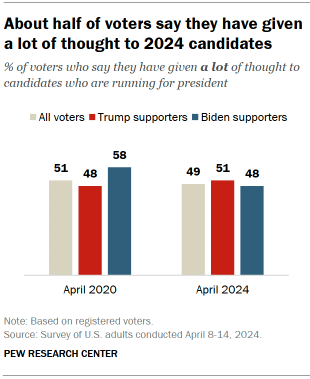
- About half of voters (49%) say they have given a lot of thought to the candidates who are running in the 2024 presidential election – nearly identical to the share saying this at a similar point four years ago (51%).
- But the share who say “it really matters who wins” in November is 5 percentage points lower than it was in April 2020.
- And most voters say, if they it were up to them, they would replace at least one of the two likely nominees (Joe Biden and Donald Trump). About half say they’d replace both Biden and Trump on the ballot.
Today, Trump and Biden supporters are about equally likely to say they’ve given a lot of thought to the presidential candidates. About half of Trump’s and Biden’s supporters say they have given a lot of thought to their options.
In April 2020, about half of voters said they had given “a lot” of thought to the candidates. But Biden’s supporters – fresh off the heels of a competitive primary – were more likely than Trump’s supporters to say they had thought a lot about the candidates (58% vs. 48%).
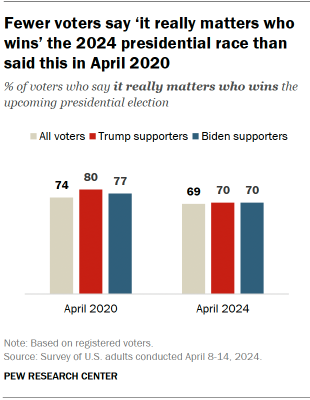
Today, 69% of voters say “it really matters who wins” the presidential election. Just 8% say it doesn’t really matter who wins, and roughly a third fall somewhere in between. However, the share of voters who say it really matters is 5 points lower than it was in April 2020, when 74% of voters said it really mattered. Both Trump and Biden supporters are lower on this measure today than four years ago.
Though both Biden and Trump have received enough delegates in the 2024 presidential primaries to secure their respective party’s nominations for president , most voters say they would like to replace at least one of them on the ballot.
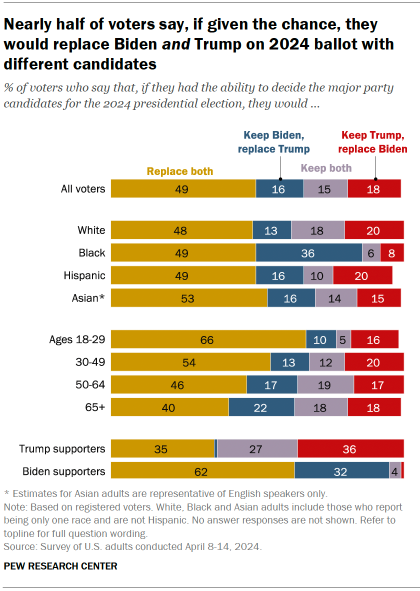
- 49% of voters say that, if they had the ability to decide the major party candidates for the 2024 presidential election, they would replace both Trump and Biden with different candidates.
- 16% say they would keep Biden but replace Trump with a different Republican.
- A similar share (18%) say they would keep Trump but replace Biden with a different Democrat.
- Another 15% of voters say they would keep the contest as is.
Demographic and political differences
There are demographic differences in desired changes to the ballot. To some extent, these are associated with voting preferences.
Biden supporters are much more likely than Trump supporters to say they’d replace both candidates if they could (62% of Biden’s supporters say this, compared with 35% of Trump’s). In contrast, Trump’s voters are much more likely than Biden’s to say they’d keep both(27% of Trump supporters vs. 4% of Biden supporters). Roughly similar shares (about a third each) of each candidate’s supporters say they would keep only their candidate and replace the other.
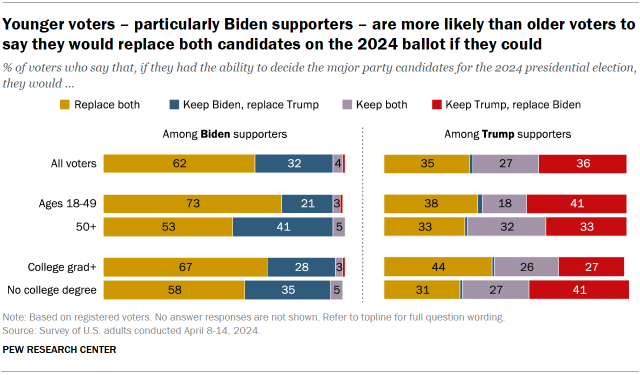
Younger voters are more likely than older voters to desire ballot changes. Roughly two-thirds of voters under 30 say they would replace both Biden and Trump on the 2024 ballot. This compares with a narrower majority of those ages 30 to 49 (54%) and smaller shares of those 50 to 64 (46%) and those 65 and older (40%).
The gap between younger and older voters is far wider among Biden’s backers:
- Nearly three-quarters of Biden supporters under 50 (73%) say they would replace both candidates. Among Biden supporters ages 50 and older, about half say they would replace both Biden and Trump (53%). In both age groups, most of those who do not want to replace both candidates say they would keep only Biden.
- Among Trump supporters, 38% of those under 50 would replace both, compared with 33% of those 50 and older. Older Trump supporters are roughly twice as likely as younger Trump supporters to say they’d keep both candidates on the ballot (32% vs. 18%). Older Trump backers are more likely than younger ones to say they’d keep Trump but replace Biden (41% vs. 33%).
Among each candidate’s supporters, those with a four-year college degree are more likely than those with less education to say they would replace both candidates if they could.
Most voters continue to say it is at least somewhat important for the losing candidate to publicly acknowledge the winner as the legitimate president of the country.
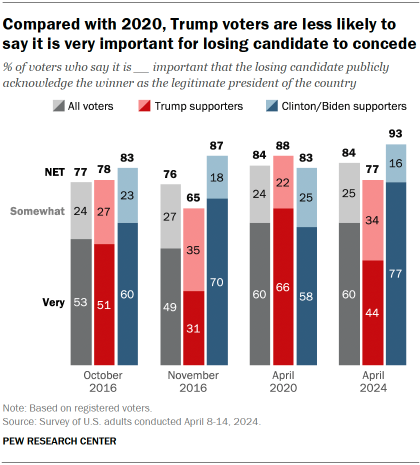
Over the past eight years, a majority of voters – regardless of who they supported for president – have said it was at least somewhat important that the losing candidate in a presidential race acknowledge the winner.
But the degree to which Trump’s supporters have said this is important has shifted over the past eight years. As the 2016 presidential election neared, Trump’s supporters became less likely to say it was important for the losing candidate to concede than they were earlier in the fall: The share who said it was very important for the loser to acknowledge the winner as the legitimate president declined by 20 percentage points between October 2016 and the eve of the November 2016 election.
In the spring of 2020, as Trump ran for reelection, 66% said this was very important.
Today, 44% of Trump’s supporters say it is very important for the losing candidate to concede. This compares with 77% of Biden’s supporters.
While there have been shifts among Clinton and Biden supporters during the same period, these changes have been much more modest. Majorities have said it is very important for the losing candidate to acknowledge the winner.
Sign up for our weekly newsletter
Fresh data delivery Saturday mornings
Sign up for The Briefing
Weekly updates on the world of news & information
- Donald Trump
- Election 2024
- Partisanship & Issues
- Presidential Approval
- Voter Demographics
- Voter Participation
Changing Partisan Coalitions in a Politically Divided Nation
About 1 in 4 americans have unfavorable views of both biden and trump, 2024 presidential primary season was one of the shortest in the modern political era, americans more upbeat on the economy; biden’s job rating remains very low, key facts about hispanic eligible voters in 2024, most popular, report materials.
- April 2024 Biden Job Approval Detailed Tables
1615 L St. NW, Suite 800 Washington, DC 20036 USA (+1) 202-419-4300 | Main (+1) 202-857-8562 | Fax (+1) 202-419-4372 | Media Inquiries
Research Topics
- Age & Generations
- Coronavirus (COVID-19)
- Economy & Work
- Family & Relationships
- Gender & LGBTQ
- Immigration & Migration
- International Affairs
- Internet & Technology
- Methodological Research
- News Habits & Media
- Non-U.S. Governments
- Other Topics
- Politics & Policy
- Race & Ethnicity
- Email Newsletters
ABOUT PEW RESEARCH CENTER Pew Research Center is a nonpartisan fact tank that informs the public about the issues, attitudes and trends shaping the world. It conducts public opinion polling, demographic research, media content analysis and other empirical social science research. Pew Research Center does not take policy positions. It is a subsidiary of The Pew Charitable Trusts .
Copyright 2024 Pew Research Center
Terms & Conditions
Privacy Policy
Cookie Settings
Reprints, Permissions & Use Policy
Wednesday briefing: Ukraine aid; TikTok ban; David Pecker at Trump’s trial; Supreme Court abortion case; campus protests; and more
The Senate approved aid for Ukraine and Israel.
- The details: A $95 billion foreign aid bill passed last night after months of debate. It will deliver weapons and support to key U.S. allies. See how your senator voted here .
- What now? President Biden said he’ll sign it into law today. Aid could arrive in Ukraine this week — a crucial boost ahead of an expected Russian offensive.
- What else to know: The bill will also ban or force a sale of TikTok .
A former tabloid boss testified in Donald Trump’s criminal trial yesterday.
- What to know: David Pecker said the National Enquirer was the “ eyes and ears ” of Trump’s 2016 campaign, sniffing out and concealing potentially scandalous stories .
- Why it matters: Prosecutors are trying to prove Trump tried to influence the election by hiding a story of an alleged affair . Trump’s lawyers are set to question Pecker tomorrow.
The Supreme Court will hear arguments today about emergency room abortions.
- The issue: Whether a federal law that requires hospitals to provide emergency care applies to abortions in life-threatening situations, even in states with strict abortion bans .
- Why it matters: It’s the latest case that could weaken abortion access after the court struck down the nationwide right to abortion in 2022. A ruling is expected this summer .
College protests over the Israel-Gaza war are continuing to spread.
- The latest: Columbia University is continuing talks today with student protesters over clearing their encampment . More than 100 were arrested at the university last week.
- Yesterday: Protesters were arrested at the University of Minnesota , and students formed a barricade at a college in Humboldt, Calif. On Monday, 120 people were arrested at NYU.
The Justice Department settled with Larry Nassar’s victims for $138.7 million.
- What to know: The payment, announced yesterday, settles 139 legal claims brought over the department’s failure to investigate allegations that could have stopped Nassar sooner.
- What he did: Nassar, a former Team USA gymnastics doctor, is serving multiple sentences related to child pornography and sexually abusing women and girls under his care.
Nearly 2 in 5 Americans have been living with unhealthy levels of air pollution.
- The numbers: 131 million Americans were living in affected areas between 2020 and 2022, a new study found. Cities in the West topped the list of most polluted places .
- It’s a problem: Poor air can increase the risk of serious health issues , make existing conditions worse and cause premature death. People of color are disproportionately affected.
Restoring sight could soon be possible.
- How? Several companies are experimenting with a type of gene therapy called optogenetics. They’re trying to create a bionic eye that can restore sight in visually impaired people .
- The timeline: Clinical trials of one product — the Science Eye — are set to begin in the next 18 months. This technology could be on the market in the next five years.
And now … spring cleaning? Tidy up your financial life with these seven tips. Plus: These 10 documents are the ones you should keep forever.
Want to catch up quickly with “The 7” every morning? Download The Post’s app and turn on alert notifications for The 7 or sign up for the newsletter .


COMMENTS
By paraphrasing, you can curate credible and well-developed documents, and arguments. But there's more to paraphrasing than the final result, the process of paraphrasing engages your ability to learn actively, write well, and communicate creatively. Amirah Khan. March 22, 2022. Paraphrasing allows you to share another's ideas in your own words.
How to Paraphrase. There's a five step approach to paraphrasing effectively. First, read the material carefully to extract meaning. It's important to develop an understanding of the points being made in order to effectively convey this meaning to another. Second, note down the key concepts.
This better understanding is an important stage in learning, and paraphrasing is an essential instrument for students. Paraphrasing is an active interaction with a text. It asks you to distinguish between the vital core concepts and the non-essential details. This judgment is the essence of critical thinking: determining what is essential vs ...
Paraphrasing • Module 3: Tips and Strategies for Successful Paraphrasing ... - Restating the important points in your own voice. 6 Module 2 Rules for Quoting, Summarizing, and Paraphrasing Quoting, Summarizing, & Paraphrasing • There are three ways to represent the work or ideas of
Paraphrasing has the power to help you connect with your audience, manage emotions, and steer the conversation. And once you begin to use the technique, you will realize it has the power to help you not only in presentations and meetings, but in virtually any interpersonal conversation. Career & Success. Share this.
Paraphrasing means putting someone else's ideas into your own words. Paraphrasing a source involves changing the wording while preserving the original meaning. Paraphrasing is an alternative to quoting (copying someone's exact words and putting them in quotation marks ). In academic writing, it's usually better to integrate sources by ...
Basics of Paraphrasing. A successful paraphrase is your own explanation or interpretation of another person's ideas. Paraphrasing in academic writing is an effective way to restate, condense, or clarify another author's ideas while also providing credibility to your own argument or analysis. While successful paraphrasing is essential for strong ...
Try these steps to write an effective paraphrase. Step 1: Read a paragraph from an article that you find interesting or that you are using to write a paper. Step 2: Make notes to yourself about the most important idea or ideas presented in the paragraph (make these notes in point form, rather than in sentences) Step 3: Put the article away and ...
Basics of Paraphrasing. A successful paraphrase is your own explanation or interpretation of another person's ideas. Paraphrasing in academic writing is an effective way to restate, condense, or clarify another author's ideas while also providing credibility to your own argument or analysis. Successful paraphrasing is essential for strong ...
Example 6. Original: "Regular exercise is crucial for maintaining optimal physical health and preventing various health issues.". Paraphrased: "Exercising regularly is important for keeping your body healthy and avoiding health problems.". In these examples, you can observe the use of different wording, sentence structure, and synonyms ...
A paraphrase (pronounced par - uh -freyz) is a restatement or rewording of a paragraph or text, in order to borrow, clarify, or expand on information without plagiarizing. Paraphrasing is an important tool to use when writing research papers, essays, and pieces of journalism. II. Examples of Paraphrasing. For examples of paraphrasing ...
To paraphrase is to 'reword' text, so that the content information stays the same while other aspects of the communication are changed. From a learning perspective, paraphrasing is really the nuts and bolts of information 'processing', done as part of taking notes or drafting new text. It is the opposite of mindlessly copying information.
Conclusion: Paraphrasing is an essential skill for any writer, enabling you to enhance clarity and originality in your writing. By paraphrasing effectively, you make complex concepts more accessible to your readers, express ideas in your own voice, avoid plagiarism, and craft engaging and unique content. Practice and refine your paraphrasing ...
By paraphrasing a text, a writer cuts down on the number of quotes in their work, making it easier to read. 7. Puts an Argument in Its Proper Place. You can set the stage for your ideas when you paraphrase. When you rework another author's words, you can guide the reader and frame your argument.
Inside the article. 1 Paraphrasing Helps you Avoid Plagiarism. 2 Paraphrasing Lets you focus on Ideas Instead of Words. 3 Paraphrasing allows you to clarify your ideas. 4 Paraphrasing is a Way to Avoid Plagiarism without Extensive Research. 5 It Makes Your Writing Better. 6 It Prevents Plagiarism. 7 Speed and time.
Effective Paraphrasing Strategies. If you are having trouble paraphrasing a text effectively, try following these steps: Reread the original passage you wish to paraphrase, looking up any words you do not recognize, until you think you understand the full meaning of and intention behind the author's words. Next, cover or hide the passage.
2. Reverse the order of the words. It is possible to rearrange the words in a sentence without changing the meaning and central concept of the text. It's almost easier to change the word order in a sentence than to search for synonyms. Adding a few words to complete the sentence may be necessary when changing the order.
Accurate: Reliable and grammatically correct paraphrasing. No sign-up required: We don't need your data for you to use our paraphrasing tool. Super simple to use: A simple interface even your grandma could use. It's 100% free: No hidden costs, just unlimited use of a free paraphrasing tool.
The QuillBot's Paraphraser is fast, free, and easy to use, making it the best paraphrasing tool on the market. You can compare results from 8 predefined modes and use the remarkable Custom mode to define and create an unlimited number of Custom modes. The built-in thesaurus helps you customize your paraphrases, and the rephrase option means you ...
As the 2016 presidential election neared, Trump's supporters became less likely to say it was important for the losing candidate to concede than they were earlier in the fall: The share who said it was very important for the loser to acknowledge the winner as the legitimate president declined by 20 percentage points between October 2016 and ...
The Chicago Bears presented city officials on Wednesday with plans, renderings and designs for a new $3.2 billion stadium on the Chicago lakefront.. Here are the renderings of what a reimagined stadium on the Chicago lakefront would look like:. Rendering courtesy of the Chicago Bears Rendering courtesy of the Chicago Bears Rendering courtesy of the Chicago Bears Rendering courtesy of the ...
Importance of Hanuman Jayanti Throughout the Ramayana, Lord Hanuman is the ideal devotee, accomplishing seemingly impossible tasks driven by his unwavering love for Rama.
The Senate approved aid for Ukraine and Israel. A former tabloid boss testified in Donald Trump's criminal trial yesterday. The Supreme Court will hear arguments today about emergency room ...